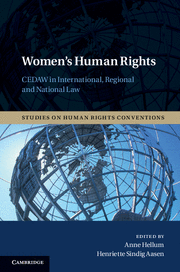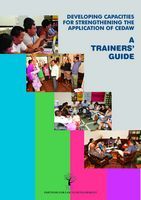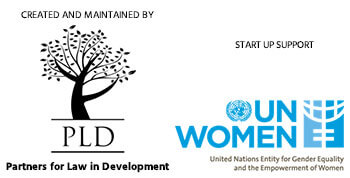This section provides an introduction to CEDAW and its functioning and the Optional Protocol to CEDAW (OP-CEDAW). It also explains their significance in international human rights law.
1. What is CEDAW?
CEDAW is an acronym for the Convention on the Elimination of All Forms of Discrimination against Women. It was adopted by the United Nations General Assembly in 1979 and came into force on 3 September 1981. It is the first international treaty that addresses discrimination against women comprehensively in all spheres of life. Consequently, it is also referred to as the international bill of rights for women. It calls on states to respect, protect, and fulfil women’s human rights, and requires states to commit to implement the treaty through ratification. The ratifying state is referred to as a state party to the Convention.
Until now, 186 countries have ratified the Convention. State parties may ratify the Convention with reservations or declarations: reservations technically limit the scope of state obligations in respective areas; declarations usually explain the circumstances that may defer or modify the implementation of the specific provisions to which they relate. Under international law, however, neither the reservations nor the declarations can be such that they defeat the very spirit and purpose of the treaty.
2. What is the difference between the adoption of a treaty and its coming into force?
Adoption is the formal act by which negotiating parties establish the form and content of a treaty. The treaty is adopted through agreement by the states and international organizations participating in the negotiation of that treaty, expressed through voting on the text, initialing, signing, etc. Once a treaty is adopted, it is open for ratification by the state parties. CEDAW required 20 such ratifications before it came into force. On 3 September 1981, 30 days after the twentieth member state had ratified it, the Convention came into force.
For any state that ratified CEDAW after 4 August 1981, the Convention came into force 30 days after the date of deposit of that state’s instrument of ratification.
3. What constitutes CEDAW?
CEDAW consists of 30 articles: Article 1 defines discrimination; Articles 2–4 cover the general obligations of the state parties; Articles 5–16 cover the substantive provisions; Articles 17–30 cover the procedural aspects and the working of the Committee.
The role and significance of the Convention should not be construed on the basis of the text alone. CEDAW is a dynamic document, the nature and scope of which is being constantly expanded through the Committee’s General Recommendations explaining the articles, the Concluding Comments issued in pursuance of the country review of the state parties, and the implementation of the Optional Protocol to CEDAW.
4. What is the Optional Protocol to CEDAW?
The Optional Protocol is an additional human rights treaty that complements CEDAW. It creates new compliance mechanisms through which individual cases of violations of women’s rights by the state can be taken up, or an inquiry into grave and systemic violations can be instituted by the Committee. These provisions are available for the state parties that have ratified CEDAW. The OP-CEDAW can also employ these provisions.
The OP-CEDAW allows the state party and its civil society to avail of the CEDAW Committee’s involvement beyond the periodic country review, thus enhancing compliance with CEDAW. It involves the Committee in the investigation of individual complaints and grave violations, thus enabling it to give its views and recommendations on addressing systemic and structural conditions underlying such violations. This allows the Committee to highlight the need for more effective remedies at the national level.
For further information on OP-CEDAW, click here
5. What is the significance of CEDAW in international human rights law?
CEDAW is an international bill of rights for women. The treaty provides a comprehensive definition of discrimination under Article 1. It identifies discrimination against women in all fields, including cultural barriers and the impact of negative stereotyping on women. It recognizes the interconnectedness of discrimination in the public and private spheres, calling for the elimination of discrimination against women simultaneously in both spaces. To do so, it holds both state and non-state actors accountable for the elimination of discrimination against women.
6. How is a state bound by the provisions of the treaty
In international law, a state undertakes the legal obligation to implement the treaty only after ratification or accession. A state may sign a treaty, but no legal obligation flows from the signing of a treaty. After ratification or accession, state parties have an obligation to incorporate the principle of equality of men and women, to abolish all discriminatory laws, and to adopt appropriate laws prohibiting discrimination against women to ensure de jure and de facto equality, to adopt measures in law and policy to fulfil the obligations of means and results, and to establish mechanisms to provide effective protection against all acts of discrimination against women by persons, organizations, or enterprises.
7. What kinds of obligation emanate from ratification of, and accession to the treaty?
Ratification constitutes the act by which a state conveys its written consent to be bound by a treaty. It is only after ratification that a state becomes party to the treaty. A minimum number of ratifications are required for a treaty to come into force. A minimum of 20 states were required to ratify CEDAW before it came into force. Accession has the same legal effect as ratification. It is the act whereby a state accepts the offer or the opportunity to become party to a treaty after the treaty has come into force. Both ratification and accession obligate governments to pursue a policy towards fulfilling the objectives of the treaty in the terms laid out in the treaty.
8. Functioning of the Treaty
1. How do state parties report under the treaty?
In accordance with Article 18 of the Convention, each state party to the Convention has to submit an initial report to the UN Secretary-General within one year of ratification. The initial report should highlight the readiness or preparedness or suitability of the country’s constitutional, legislative, and administrative framework for the implementation of the Convention, as well as explain the legal and practical measures that have been, or will be, adopted to give effect to the provisions of the Convention. Thereafter, the state party should submit periodic reports every four year. The Committee can also demand reports from the state parties. These are called exceptional reports. In the event of delay in the submission of periodic reports beyond the stipulated period of four years, the state parties have the option of combining the periodic reports.
2. To whom do the state parties report?
The state parties report to the CEDAW Committee, established under Article 17 of the Convention, which comprises 23 experts who are individuals of high moral standing and competence in the field covered by the Convention.
3. How is the CEDAW Committee constituted?
Article 17 states that the members of the Committee shall be elected for a term of four years. Each state party has the right to nominate one person, who is elected through the process of secret ballot. The election of the Committee members is based on the need to ensure equitable geographical distribution of membership, the requirement to represent different legal systems, and the need to ensure regional representation.
4. What are the functions of the CEDAW committee?
The main functions of the Committee are reviewing the reports submitted by the state parties, issuing General Comments, which elaborate on the articles of the Convention, and facilitating the implementation of the Optional Protocol to CEDAW. During the presentation of the report by the state party, the Committee engages in a constructive dialogue with the concerned government delegation. A country review involves the issuing of Concluding Observations upon the examination of the state party’s report. The Committee also issues General Comments, which are interpretative comments on specific articles of the Convention.
9. General Comments
The General Recommendations, are interpretative comments on different articles of the Convention or the thematic areas addressed by it. Until date, 28 General Recommendations have been issued by the Committee. Some important General Recommendations (hereafter referred to as GC) are: GC 19 on violence against women (VAW); GC 21 on women’s equality within marriage and family relations; GC 25 on temporary special measures; GC 26 on women migrant workers; and GC 28 on the core obligations of the state parties under Article 2 of CEDAW. The General Recommendations elaborate on the scope and nature of the Convention by addressing contemporary and cross-cutting issues that might not have been explicitly mentioned in the Convention earlier.
10. Concluding Observations
Concluding Observations, which were formerly known as Concluding Comments, are issued by the CEDAW Committee upon examination of the state party’s report. Concluding Observations are recommendations issued by the Committee to highlight the achievements of the state party in implementing the Convention or to identify the major areas of concern regarding which a state party needs to take action and which require further improvement. Follow-up and implementation of the Concluding Observations are imperative for the state party. Concluding Observations serve as an advocacy tool to highlight the gaps in, or the limitations of, a particular law, policy, or programme, or to identify and point to ineffective government action on a particular issue or area of concern.
To check the Concluding Observations issued in regard to various countries in South Asia, please see the Resource section.










